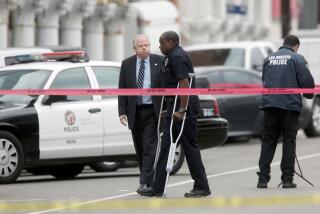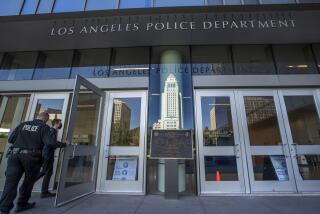Justice Must Be Swift--but Also Just
- Share via
The ritual has become distressingly familiar. The long, black car gliding through hushed streets. A waterfall of uniforms--dark blue, green and khaki--cascading down church steps. Sunlight glinting off polished metal badges, many of them banded in black, as a casket passes through the ranks. A grieving family, the spouse or parent numbly accepting an American flag that has been folded into taut, military triangles.
Police officers are being killed at an alarming rate these days. Not while shooting it out with bank robbers, but because they’re cops--and because the people who are killing them assume they can get away with doing it.
Certainly that’s been the case in many Southern California slayings, including the most recent, of Officer Filbert Cuesta Jr., shot as he and his partner waited in their squad car for backup to approach a party that had gotten out of hand.
Predictably, the response has been swift and fierce. The LAPD assigned 25 detectives from its elite Robbery-Homicide Division to track down Cuesta’s killers. And predictably, a key suspect, Catarino Gonzalez Jr., is now in custody. That fact inspired Mayor Richard Riordan to express his relief “that the LAPD has gotten a murderer off the streets of Los Angeles.”
Ah, such certainty! Riordan is a politician and not a practicing lawyer, but one would presume that the head of local government would deem it prudent to place the word “alleged” before “killer,” if only to give lip service to the presumption of innocence, that pesky (alleged) constitutional guarantee. He wasn’t alone; Councilwoman Laura Chick noted her approval of swift police action in a public statement, adding that she hoped “Cuesta’s family can rest now that this killer is in custody.”
The immediate search and roundup of presumed cop-killers is logical. Police represent the authority of the state, and, the theory goes, attacks on the state’s authority must be dealt with quickly and unambiguously, lest we descend into anarchy. As Laurie Levenson, associate dean of Loyola Law School, points out, “When you kill a cop, you’re talking about a whole different ball game.” From the state’s perspective, “If you let them [cops] go down, who will be safe?”
That’s a conclusion that the public seems to be reaching as well. In the 1960s, in some communities, assaults on police were considered political acts. Police requests for information that could lead to apprehension often were met with shrugs, disclaimers, “never-saw-the-guy” responses. Residents of inner cities, particularly, often felt the police’s presence as an occupying army, agents whose methods of containment or subjugation were employed with more force than the occasion warranted.
But Americans have reached a zero-tolerance for street crime, and with that posture has come a new attitude toward the police, especially from residents in the inner city. “The general public is fed up with crime,” says Levenson, “but people who live in crime-ridden neighborhoods are the most fed up. It’s their kids, their friends, their parents who are being killed.” Since the late ‘60s, more forces around the country have become diversified; they better reflect the communities they serve. People who used to be reluctant to give information are coming forward because they are tired of being afraid to leave their homes, tired of keeping their children inside because their front yards have become potential killing fields.
In Los Angeles, diversity and community policing have resulted in a new partnership in many neighborhoods. “There’s been a major effort since Rodney King and the Christopher Commission to go out into these communities and create alliances,” Levenson notes, “empowering ‘good’ groups [such as block clubs, citizen auxiliary patrols], investing in leadership and youth programs.” Which, in combination, have helped to reduce the crime rates in Los Angeles and other large cities.
But it’s important to reduce the crime rate by apprehending the right criminal. And while the temptation to have a “murderer off the streets of Los Angeles” is understandable, it’s not necessarily in the public’s best interest. After all, if the wrong man is in custody, the right man is still out there somewhere. And if the right man is still at liberty, we’re sleeping wrapped in a blanket of false security. And Cuesta will not yet have received the justice he and his family deserve.
More to Read
Sign up for Essential California
The most important California stories and recommendations in your inbox every morning.
You may occasionally receive promotional content from the Los Angeles Times.










